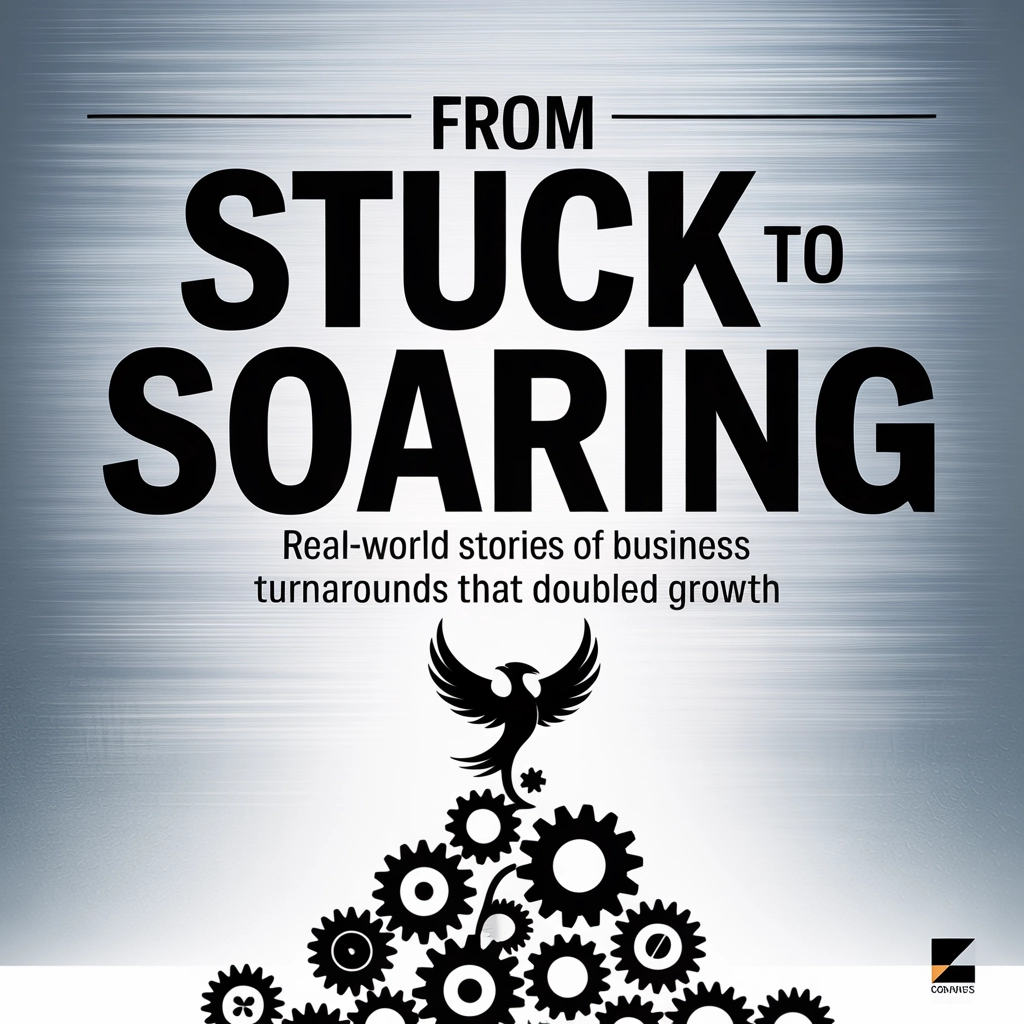In the business world, comeback stories aren't just inspiring—they're educational gold mines. At some point, even the most successful companies have faced existential threats. What separates those that crumble from those that come back stronger than ever? As we've seen with our clients at C Life and Partners, the difference often lies in strategic vision, decisive action, and sometimes, a complete reinvention.
Today, we're diving into remarkable business turnaround stories where companies didn't just recover—they doubled their growth and transformed their trajectories entirely. These real-world examples prove that with the right approach, a struggling business can not only survive but thrive beyond previous limitations.
When Giants Stumble: The Apple Renaissance
In the mid-1990s, Apple Computer was 90 days from bankruptcy. The company Steve Jobs had co-founded was being crushed by Microsoft and losing market share at an alarming rate. The tech pioneer that had revolutionized personal computing was on life support.
When Jobs returned in 1997, he made several bold moves that seemed counterintuitive at the time:
- He dramatically simplified the product line, cutting 70% of Apple's products
- He signed a controversial partnership with arch-rival Microsoft
- He completely reimagined Apple's design philosophy with the iconic, colorful iMac
The results speak for themselves. Apple transformed from a struggling computer manufacturer to one of the most valuable companies in history, with annual revenues approaching $300 billion. The company that was nearly bankrupt now has more cash reserves than many countries' GDPs.
The Turnaround Lesson: Sometimes saving a business requires ruthless prioritization and the courage to abandon what isn't working, even if it was once core to your identity.
Building Back Block by Block: LEGO's Remarkable Recovery
In 2003, LEGO was on the brink of bankruptcy, bleeding money and losing relevance in a digital world. The Danish toy maker had strayed from its core plastic brick sets, diversifying into clothing, theme parks, video games, and watches—most of which were failing spectacularly.

The turnaround strategy focused on three pillars:
- Back to Basics: LEGO refocused on its core brick products and what made them special
- Cut the Fat: The company sold off non-essential assets like the LEGOLAND parks
- Find New Audiences: LEGO actively engaged with adult fans and created premium sets with higher margins
By 2015, LEGO had become the most valuable toy company in the world, surpassing Mattel. The company that was losing a million dollars a day is now a global powerhouse with double-digit profit margins.
The Turnaround Lesson: When diversification dilutes your core strengths, returning to what you do best—but with fresh innovation—can rekindle growth.
From Comics to Empire: Marvel's Blockbuster Comeback
In 1996, Marvel filed for bankruptcy protection after years of declining comic book sales and failed diversification attempts. The company that created iconic characters like Spider-Man and the X-Men seemed destined for the dustbin of pop culture history.
The turnaround came through strategic licensing, a bold new film strategy, and visionary leadership:
- Marvel began producing its own films instead of just licensing characters
- It created an interconnected cinematic universe (the MCU), a revolutionary approach to storytelling
- The company leveraged character popularity into merchandise, theme park attractions, and more
The results transformed entertainment forever. Disney eventually acquired Marvel for $4 billion in 2009, and the MCU has since generated over $25 billion in box office revenue alone. A company once valued at just $140 million created a multi-billion-dollar empire.
The Turnaround Lesson: Identifying your truly valuable assets (in Marvel's case, its character library) and finding innovative ways to monetize them can lead to exponential growth.
The Logistics Leader: FedEx's Delivery from Disaster
Few people remember that FedEx—now synonymous with reliable delivery—nearly collapsed in its early days. Within three years of its founding, the company was losing over $1 million monthly and faced fuel bills it couldn't pay.

Founder Fred Smith's legendary story of winning $27,000 in Las Vegas to make payroll is just part of the tale. The real turnaround came through:
- Securing crucial investment by demonstrating the viability of its hub-and-spoke model
- Relentless focus on operational excellence and reliability
- Strategic adaptation to changing market needs, eventually including ground service to compete with UPS
FedEx became the first American startup to reach $1 billion in revenue without mergers or acquisitions. Today, it's a global logistics giant with over $90 billion in annual revenue.
The Turnaround Lesson: Sometimes perseverance through the darkest days, combined with unwavering belief in your core business model, is what's needed to break through to success.
Retail Reinvention: Walmart's Digital Transformation
While Walmart was never close to bankruptcy, the retail giant faced an existential threat as Amazon revolutionized shopping habits. By 2015, Walmart was struggling with flat growth and seemed unprepared for the e-commerce revolution.
The company's comprehensive turnaround strategy included:
- Major investments in e-commerce capabilities and acquisitions like Jet.com
- Reimagining stores as fulfillment centers for online orders
- Launching grocery pickup and delivery services
- Focusing on employee training and compensation to improve the in-store experience
The results have been remarkable. Walmart has seen significant growth in consolidated net sales and operating income, with its e-commerce business growing at double-digit rates. The company once dismissed as unable to compete online now threatens Amazon's dominance in many retail categories.
The Turnaround Lesson: Even industry leaders must be willing to transform their business models when market disruption occurs. Strategic planning can help anticipate these shifts before they become crises.
Small Business Success: Smokey John's Bar-B-Que
Not all turnaround stories involve global corporations. Smokey John's Bar-B-Que, a family-owned restaurant in Dallas, faced disaster when a fire destroyed their location in 2017. Instead of giving up, the owners pivoted their business model:
- They focused on catering and food truck operations while rebuilding
- They diversified by bottling their signature barbecue sauce and rubs
- They leveraged community relationships to maintain visibility

When they reopened, they had multiple revenue streams instead of just one. Their diversification strategy not only saved the business but positioned it for greater growth than before the fire.
The Turnaround Lesson: Adversity can be the catalyst for beneficial changes you might never have made otherwise. Small businesses can often pivot more nimbly than large corporations.
Common Threads in Successful Turnarounds
While each turnaround story is unique, certain patterns emerge across these success stories:
1. Honest Assessment of Reality
Successful turnarounds begin with brutal honesty. Leaders must acknowledge the true severity of their situation without sugar-coating it. At C Life and Partners, we've found that facing uncomfortable truths is always the first step toward recovery.
2. Return to Core Strengths
Many struggling businesses have diversified too far from what made them successful in the first place. Identifying and recommitting to core competencies—while shedding distractions—is often critical to recovery.
3. Embrace Innovation, Not Just Cost-Cutting
While reducing expenses is typically necessary, companies that achieve dramatic turnarounds don't simply shrink their way to success. They innovate, finding new ways to deliver value that competitors can't easily replicate.
4. Leadership That Inspires Confidence
Turnarounds require buy-in from employees, investors, customers, and suppliers—all of whom may be skeptical after witnessing decline. Leaders must communicate a compelling vision that rebuilds trust and enthusiasm.
5. Strategic Use of Available Resources
Successful turnarounds rarely have abundant resources. They require strategic allocation of limited capital toward initiatives with the highest potential return. Our financial planning services help businesses make these crucial decisions.
Could Your Business Be the Next Great Comeback Story?
These turnaround stories demonstrate that no business situation is truly hopeless with the right strategy and execution. Whether you're facing serious challenges or simply looking to accelerate growth, the principles that drove these remarkable recoveries can be applied to businesses of any size.
At C Life and Partners, we specialize in helping businesses identify their path from stuck to soaring. Our team brings decades of experience in business consulting and strategic planning to organizations at all stages of their journey.
Remember: today's struggling business could be tomorrow's case study in spectacular success. The companies we've highlighted didn't just recover—they reinvented themselves into something stronger than before.
What could your business become if you approached challenges as opportunities for transformation rather than merely problems to solve? The answer might be more extraordinary than you imagine.
Ready to write your own turnaround story? Contact us to start the conversation about your business's untapped potential.
